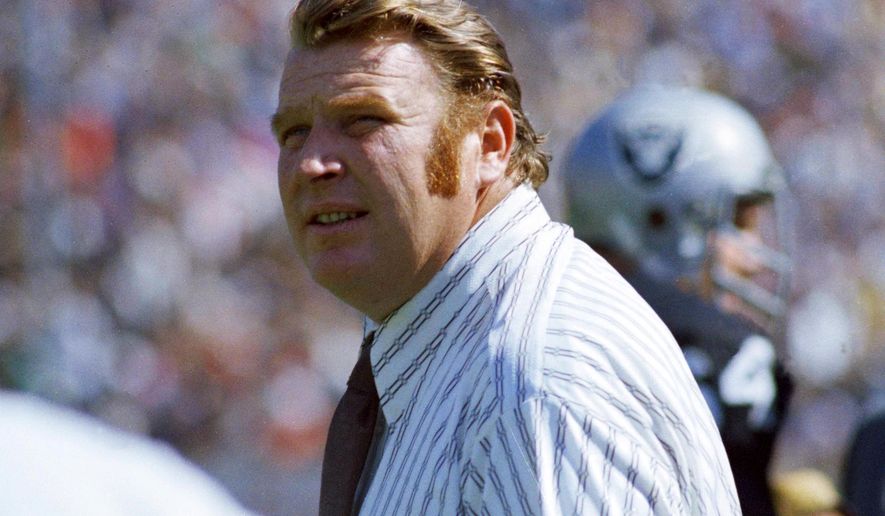John Madden, who passed away Tuesday at the age of 85, didn’t just love life. He loved lives.
He didn’t just connect with people. He connected with humanity.
His first move upon meeting someone was not to act like he was John Madden, Hall of Fame football coach, television star and video game icon. He was John Madden, a guy.
“He was very accommodating,” said local legendary television producer Ernie Baur, who worked with Madden on many CBS Football telecasts. “He was kind of quiet but very accommodating to anyone who came up to him. He didn’t put off people at all.”
God knows he could have. Madden could have big-timed nearly anyone, and had the credentials to do it.
When Madden was hired to coach the American Football League powerhouse Oakland Raiders in 1969, he was 32, at the time the youngest coach in NFL history. He led the Raiders to a 12-1-1 record that season, losing to the rival Kansas City Chiefs in the AFC championship game.
He would take the Raiders to five AFC title games in seven years before finally breaking through in 1976 and winning the Super Bowl with a 32-14 victory over the Minnesota Vikings. He retired after the 1978 season with a 103-32-7 regular-season record, the best among coaches with more than 100 games.
Madden’s life and persona would only get bigger as a broadcaster. He captured the hearts of not just sports fans, but television viewers everywhere with his demonstrative style of analysis in the booth — shouting “Boom” while frantically describing a big play. His fear of flying evolved into another piece of the legend — the Madden Cruiser, the bus he took from city to city for telecasts, the bus that is on display on the grounds of the Pro Football Hall of Fame.
Madden also became a sought-after commercial pitchman, standing out among a collection of sports personalities in the memorable Miller Lite commercials. Then came his presence for a whole new generation as the model for the successful Madden Football video game.
He was no clown, though. Madden won 16 Emmy Awards over his work with four different networks. No one has come along since to match his personality and knowledge in the booth.
Baur began occasionally working with Madden when the former coach started in the booth.
“Madden didn’t start off as the No. 1 guy,” Baur said. “He would work the lower games that didn’t reach out to that many markets. I worked some of those games with him. We would go out to dinner as part of the production team. He wasn’t the loudest guy at the table, but he laughed at everything and had a great sense of humor.
“He got the greatest kick out of me doing Warner Wolf impressions,” Baur said. “I’d get in his ear and do it and he would laugh and say, ’C’mon Ernie, stop it.’”
Madden was the signature television voice for many Washington football fans during the 1980s glory days of the franchise, when the team was the marquee attraction on CBS Sunday telecasts. He was close to coach Joe Gibbs — they used to coach together at San Diego State under legendary play-caller Don Coryell — but Madden particularly loved coming to RFK Stadium and the boisterous home crowd.
“Madden loved the old stadium and the old dirt and the fans, blue-collar great fans,” Baur said. “He got along with those kind of fans.”
He and Pat Summerall did the final Washington football telecast from RFK in 1996.
“To me, the Redskins will always be Riggins and the Hogs, Gary Clark going crazy on the sidelines, Joe Gibbs, Darrell Green,” Madden told The Washington Post before the final game. “You remember when they’d get the ball and just run it down your throat, Joe Jacoby, Russ Grimm, that whole thing, and that whole place just shaking. It’s the only place we go where the booth would start shaking. You’d put the time of the game left on the screen and the picture would be bouncing around. It would go in and out of the frame.
“You remember LT (New York Giants linebacker Lawrence Taylor) coming in there and his battles with Jacoby,” he said. “And the place is so intimate, the people are right there on top of you. We were in here earlier and talking about the best places to broadcast from, and Pat said, Right here, right here in RFK!’ Why? Because you’re so close to the field.”
Then, in addition to being a great football coach, television personality and video game legend, Madden became a prophet.
“I’m sure the new place will be bigger and nicer and more parking and more efficient and all that,” he said. “But the tough part about it is you’ll never have this again, and there’s not a whole bunch of these places left. There’s no place like it, and there never will be again. To me, that’s kind of sad.”
How did he know? Because John Madden loved lives. He connected with humanity. And somehow he knew that both would probably be missing at Ghost Town Field.
Hear Thom Loverro on The Kevin Sheehan Show podcast.
• Thom Loverro can be reached at tloverro@washingtontimes.com.




Please read our comment policy before commenting.